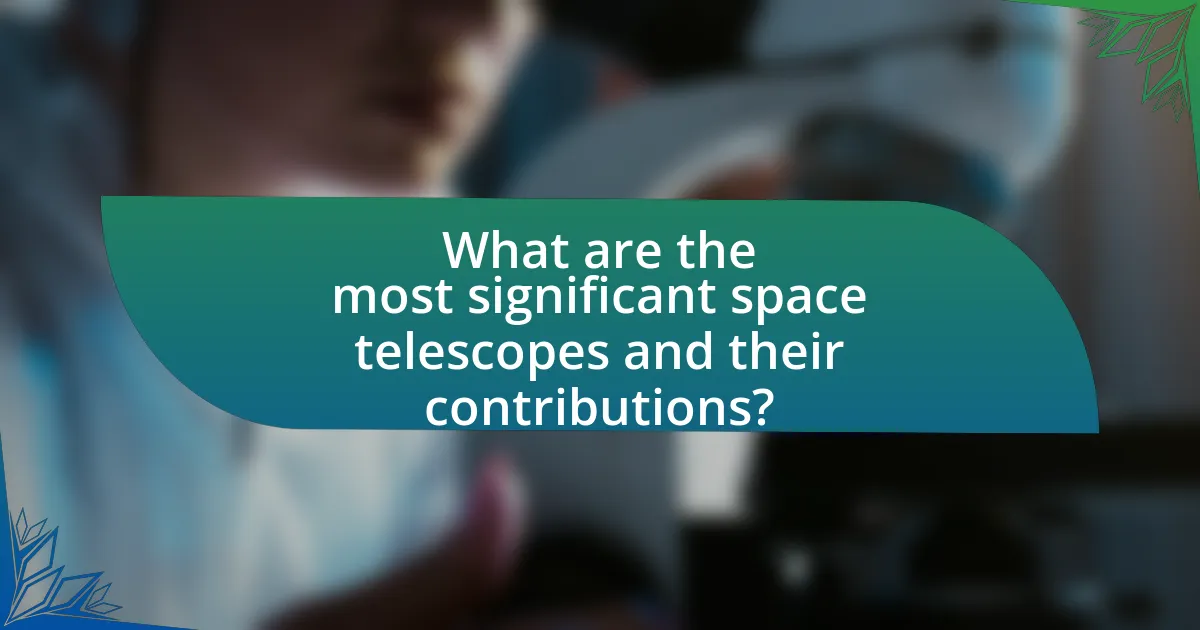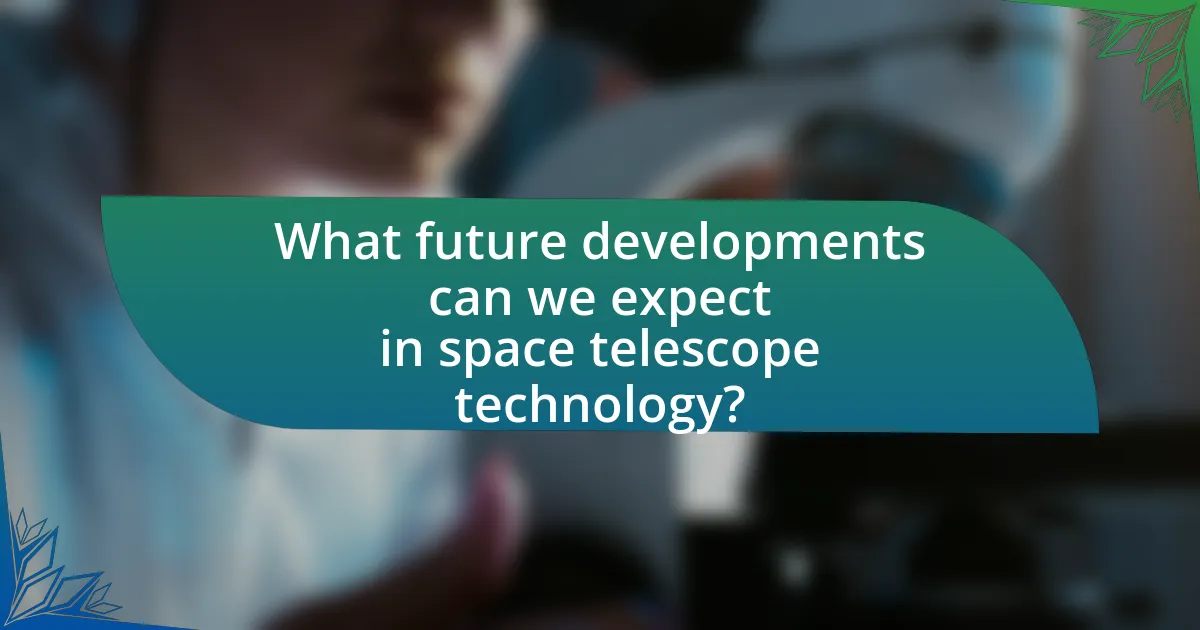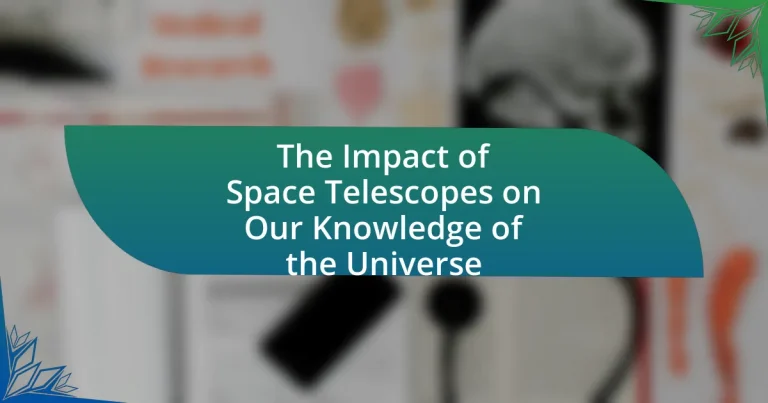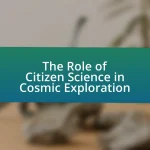Space telescopes, such as the Hubble Space Telescope and the James Webb Space Telescope, have profoundly impacted our understanding of the universe by providing clear and detailed astronomical observations. These instruments have facilitated significant discoveries, including the detection of exoplanets, insights into the expansion of the universe, and evidence of dark energy. By operating above Earth’s atmosphere, space telescopes capture a broader spectrum of electromagnetic radiation, enhancing our knowledge of celestial phenomena and the potential for life beyond Earth. The advancements in technology and collaborative efforts with ground-based observatories further amplify their contributions to modern astronomy, shaping our comprehension of cosmic evolution and the structure of the universe.

What is the impact of space telescopes on our knowledge of the universe?
Space telescopes significantly enhance our knowledge of the universe by providing unprecedented clarity and detail in astronomical observations. Instruments like the Hubble Space Telescope have allowed scientists to observe distant galaxies, nebulae, and exoplanets, leading to groundbreaking discoveries such as the acceleration of the universe’s expansion and the presence of water vapor in the atmospheres of distant worlds. These observations have been crucial in refining our understanding of cosmic phenomena, including the formation and evolution of stars and galaxies. The data collected from space telescopes has also contributed to the development of theories regarding dark matter and dark energy, fundamentally altering our comprehension of the universe’s structure and fate.
How have space telescopes changed our understanding of celestial phenomena?
Space telescopes have significantly enhanced our understanding of celestial phenomena by providing unprecedented clarity and detail in astronomical observations. For instance, the Hubble Space Telescope has captured images of distant galaxies, revealing their formation and evolution over billions of years, which has led to insights into the rate of expansion of the universe. Additionally, the Kepler Space Telescope has identified thousands of exoplanets, expanding our knowledge of planetary systems and the potential for life beyond Earth. These advancements are supported by data showing that Hubble’s observations have contributed to the discovery of dark energy, fundamentally altering our comprehension of cosmic dynamics.
What specific discoveries have been made possible by space telescopes?
Space telescopes have enabled significant discoveries, including the detection of exoplanets, the observation of distant galaxies, and the measurement of cosmic background radiation. For instance, the Hubble Space Telescope has provided evidence of the accelerated expansion of the universe through observations of distant supernovae, leading to the conclusion that dark energy constitutes about 68% of the universe. Additionally, the Kepler Space Telescope has confirmed thousands of exoplanets, expanding our understanding of planetary systems beyond our own. These discoveries have fundamentally transformed our knowledge of the universe’s structure, composition, and evolution.
How do space telescopes enhance our view of distant galaxies?
Space telescopes enhance our view of distant galaxies by operating above Earth’s atmosphere, which allows them to capture clearer and more detailed images without atmospheric distortion. For example, the Hubble Space Telescope has provided unprecedented views of galaxies billions of light-years away, revealing intricate structures and phenomena such as star formation and galaxy collisions. This capability is supported by advanced instruments that can observe across various wavelengths, including ultraviolet and infrared, which are often blocked by the atmosphere. Consequently, space telescopes significantly improve our understanding of the universe’s evolution and the formation of galaxies.
Why are space telescopes essential for modern astronomy?
Space telescopes are essential for modern astronomy because they provide unobstructed views of the universe, free from Earth’s atmospheric interference. This capability allows astronomers to observe celestial phenomena across various wavelengths, including ultraviolet, infrared, and X-rays, which are often absorbed or scattered by the atmosphere. For instance, the Hubble Space Telescope has contributed to significant discoveries, such as determining the rate of expansion of the universe and identifying exoplanets. These observations enhance our understanding of cosmic events and the formation of galaxies, making space telescopes crucial tools for advancing astronomical knowledge.
What limitations do ground-based telescopes face compared to space telescopes?
Ground-based telescopes face significant limitations compared to space telescopes primarily due to atmospheric interference. The Earth’s atmosphere distorts and absorbs light from celestial objects, which can reduce image clarity and limit the wavelengths that can be observed. For instance, ground-based telescopes cannot effectively observe ultraviolet and X-ray wavelengths because these are absorbed by the atmosphere. Additionally, light pollution from urban areas further degrades the quality of observations made from the ground. In contrast, space telescopes operate above the atmosphere, allowing for clearer images and the ability to observe a broader spectrum of electromagnetic radiation, including infrared and ultraviolet light. This capability enhances our understanding of the universe, as demonstrated by the Hubble Space Telescope, which has provided unprecedented views of distant galaxies and cosmic phenomena.
How do space telescopes contribute to the study of exoplanets?
Space telescopes significantly enhance the study of exoplanets by providing high-resolution observations that are not hindered by Earth’s atmosphere. These telescopes, such as the Kepler Space Telescope and the Transiting Exoplanet Survey Satellite (TESS), utilize methods like the transit method to detect exoplanets by measuring the dimming of stars as planets pass in front of them. For instance, Kepler discovered over 2,600 confirmed exoplanets during its mission, demonstrating the effectiveness of space-based observations in identifying distant worlds. Additionally, space telescopes can analyze the atmospheres of exoplanets through spectroscopy, revealing the chemical composition and potential habitability of these distant planets. This capability has been crucial in identifying potentially Earth-like exoplanets in the habitable zones of their stars, thereby expanding our understanding of the universe and the potential for life beyond Earth.
What role do space telescopes play in the search for extraterrestrial life?
Space telescopes play a crucial role in the search for extraterrestrial life by enabling the observation of distant exoplanets and their atmospheres. These telescopes, such as the Hubble Space Telescope and the upcoming James Webb Space Telescope, utilize advanced technology to detect light from distant stars and analyze the spectral signatures of planets orbiting them. For instance, the Hubble Space Telescope has successfully identified water vapor in the atmospheres of exoplanets, providing evidence of potentially habitable conditions. Additionally, space telescopes can monitor the chemical composition of these atmospheres for biosignatures, such as oxygen and methane, which may indicate the presence of life. This capability significantly enhances our understanding of the universe and the potential for life beyond Earth.
How do space telescopes help identify potentially habitable planets?
Space telescopes help identify potentially habitable planets by detecting exoplanets through methods such as transit photometry and direct imaging. Transit photometry measures the dimming of a star’s light as a planet passes in front of it, allowing astronomers to infer the planet’s size and orbital period. For instance, NASA’s Kepler Space Telescope has discovered thousands of exoplanets using this technique, identifying many within the habitable zone where conditions may support liquid water. Direct imaging captures light from exoplanets, enabling the analysis of their atmospheres for signs of habitability, such as the presence of water vapor or oxygen. This combination of techniques provides critical data on the characteristics of exoplanets, enhancing our understanding of which may support life.
What evidence have space telescopes provided regarding life beyond Earth?
Space telescopes have provided significant evidence regarding the potential for life beyond Earth, primarily through the discovery of exoplanets in habitable zones and the detection of organic molecules. For instance, the Kepler Space Telescope has identified thousands of exoplanets, with many located in their star’s habitable zone, where conditions may support liquid water, a key ingredient for life. Additionally, the Hubble Space Telescope has detected organic compounds, such as methane and carbon dioxide, in the atmospheres of distant planets, suggesting the presence of building blocks for life. These findings support the hypothesis that life could exist elsewhere in the universe, as they indicate environments that may be conducive to biological processes.
How do space telescopes collaborate with other astronomical instruments?
Space telescopes collaborate with other astronomical instruments by combining data to enhance observational capabilities and provide a more comprehensive understanding of celestial phenomena. For instance, the Hubble Space Telescope often works in conjunction with ground-based observatories, such as the Keck Observatory, to achieve higher resolution images and gather complementary data across different wavelengths. This collaboration allows astronomers to confirm findings, such as the discovery of exoplanets, by cross-referencing observations from both space and ground-based instruments. Additionally, missions like the James Webb Space Telescope are designed to work alongside existing telescopes, utilizing their unique capabilities to explore the universe in infrared while other instruments focus on optical or radio wavelengths. This multi-instrument approach leads to richer scientific insights and more accurate models of cosmic events.
What advancements in technology have improved space telescopes’ capabilities?
Advancements in technology that have improved space telescopes’ capabilities include the development of larger and more sensitive detectors, adaptive optics systems, and advanced data processing algorithms. Larger detectors, such as those used in the James Webb Space Telescope, allow for greater light collection and improved image resolution, enabling the observation of fainter and more distant celestial objects. Adaptive optics systems correct for atmospheric distortion in real-time, enhancing image clarity. Additionally, sophisticated data processing algorithms, including machine learning techniques, enable more efficient analysis of vast amounts of data, facilitating the discovery of new astronomical phenomena. These technological improvements collectively enhance the observational power and scientific output of space telescopes.

What are the most significant space telescopes and their contributions?
The most significant space telescopes include the Hubble Space Telescope, the Chandra X-ray Observatory, and the Kepler Space Telescope, each contributing uniquely to our understanding of the universe. The Hubble Space Telescope, launched in 1990, has provided deep-field images revealing thousands of galaxies, contributing to the understanding of cosmic expansion and the existence of dark energy. The Chandra X-ray Observatory, operational since 1999, has allowed astronomers to study high-energy phenomena such as black holes and supernova remnants, enhancing knowledge of the universe’s most energetic processes. The Kepler Space Telescope, launched in 2009, has discovered thousands of exoplanets, significantly advancing the search for potentially habitable worlds beyond our solar system. These telescopes have collectively transformed our comprehension of astronomical phenomena and the structure of the universe.
What are the key features of the Hubble Space Telescope?
The key features of the Hubble Space Telescope include its ability to capture high-resolution images in visible, ultraviolet, and near-infrared wavelengths, which allows for detailed observations of astronomical objects. Hubble’s 2.4-meter primary mirror enables it to observe distant galaxies, nebulae, and other celestial phenomena with clarity. Additionally, its location above Earth’s atmosphere eliminates atmospheric distortion, resulting in clearer images. Hubble has made significant contributions to our understanding of the universe, including the discovery of the accelerating expansion of the universe and the identification of exoplanets. These features collectively enhance its role as a vital tool in modern astronomy.
How has Hubble’s data transformed our understanding of the universe?
Hubble’s data has fundamentally transformed our understanding of the universe by providing precise measurements of cosmic distances and revealing the expansion rate of the universe. This data led to the discovery of dark energy, which constitutes approximately 68% of the universe and drives its accelerated expansion. Hubble’s observations of distant galaxies and supernovae have allowed astronomers to refine the Hubble Constant, which quantifies the rate of expansion, with recent measurements indicating a value of about 73 kilometers per second per megaparsec. Additionally, Hubble’s imaging capabilities have unveiled the existence of exoplanets and detailed the structure of galaxies, enhancing our knowledge of galaxy formation and evolution.
What are some landmark discoveries made by Hubble?
The Hubble Space Telescope has made several landmark discoveries, including the determination of the rate of expansion of the universe, known as the Hubble Constant, which was refined to approximately 70 kilometers per second per megaparsec. Hubble’s observations of distant supernovae led to the discovery of dark energy, a mysterious force driving the accelerated expansion of the universe. Additionally, Hubble provided evidence for the existence of exoplanets and captured detailed images of galaxies, nebulae, and other celestial phenomena, significantly enhancing our understanding of cosmic evolution and structure. These discoveries have fundamentally changed our comprehension of the universe’s history and composition.
What innovations have been introduced with the James Webb Space Telescope?
The James Webb Space Telescope has introduced several key innovations, including its large segmented mirror, advanced infrared capabilities, and a sunshield that protects its instruments from solar radiation. The telescope’s 6.5-meter primary mirror, composed of 18 hexagonal segments, allows for unprecedented light-gathering power, enabling observations of distant galaxies and exoplanets. Its ability to observe in the infrared spectrum, particularly in the 0.6 to 28 micrometer range, facilitates the study of celestial objects that are too cool or faint to be seen in visible light. Additionally, the sunshield, roughly the size of a tennis court, maintains the telescope’s instruments at extremely low temperatures, essential for accurate infrared measurements. These innovations collectively enhance our understanding of the universe, allowing scientists to explore the formation of stars, galaxies, and planetary systems in greater detail than ever before.
How does JWST differ from its predecessors in terms of technology?
The James Webb Space Telescope (JWST) differs from its predecessors primarily through its advanced infrared technology and larger mirror size. JWST features a 6.5-meter primary mirror, significantly larger than the Hubble Space Telescope’s 2.4-meter mirror, allowing it to collect more light and observe fainter objects. Additionally, JWST operates primarily in the infrared spectrum, enabling it to see through dust clouds and observe distant galaxies, star formation, and exoplanets more effectively than previous telescopes that focused mainly on visible light. This technological advancement is supported by its innovative sunshield, which protects its instruments from solar radiation, maintaining the necessary low temperatures for infrared observations.
What new areas of research does JWST open up for astronomers?
The James Webb Space Telescope (JWST) opens up new areas of research for astronomers, particularly in the study of exoplanets, the early universe, and galaxy formation. JWST’s advanced infrared capabilities allow for the detailed analysis of exoplanet atmospheres, enabling the detection of chemical signatures that indicate potential habitability. Additionally, JWST can observe the formation of the first galaxies and stars, providing insights into cosmic evolution shortly after the Big Bang. Its ability to peer through cosmic dust enhances the understanding of star formation processes and the lifecycle of galaxies. These capabilities are supported by its large mirror and sensitive instruments, which significantly improve upon the observational limits set by previous telescopes like Hubble.
What other notable space telescopes exist and what have they achieved?
Notable space telescopes include the Hubble Space Telescope, the Chandra X-ray Observatory, and the Kepler Space Telescope, each achieving significant advancements in our understanding of the universe. The Hubble Space Telescope has provided deep field images revealing thousands of galaxies, contributing to the understanding of cosmic expansion and the age of the universe. The Chandra X-ray Observatory has enabled the study of high-energy phenomena, such as black holes and supernova remnants, enhancing knowledge of the universe’s most energetic processes. The Kepler Space Telescope has discovered thousands of exoplanets, significantly advancing the search for potentially habitable worlds beyond our solar system. These telescopes collectively have transformed astrophysics and cosmology through their groundbreaking discoveries and observations.
How has the Chandra X-ray Observatory contributed to our knowledge of black holes?
The Chandra X-ray Observatory has significantly advanced our understanding of black holes by providing high-resolution X-ray images and spectra that reveal the behavior of matter in extreme gravitational fields. Through its observations, Chandra has identified and studied the X-ray emissions from supermassive black holes at the centers of galaxies, such as the one in the Milky Way, known as Sagittarius A*. Additionally, Chandra has detected X-ray binaries, which are systems where a black hole is pulling material from a companion star, allowing scientists to study the accretion processes and the effects of strong gravity. These findings have been crucial in confirming the existence of black holes and understanding their formation and growth, as evidenced by the detailed data published in numerous scientific journals, including the Astrophysical Journal.
What insights has the Kepler Space Telescope provided about exoplanets?
The Kepler Space Telescope has provided critical insights into the existence and characteristics of exoplanets, discovering over 2,600 confirmed exoplanets during its mission. This telescope utilized the transit method, detecting dips in brightness of stars caused by planets passing in front of them, which allowed for the identification of planets in various sizes and orbits. Notably, Kepler revealed that planets are common in the Milky Way, with estimates suggesting that there could be billions of Earth-sized planets in the habitable zones of stars. Additionally, Kepler’s data has contributed to the understanding of planetary systems’ diversity, including the prevalence of super-Earths and mini-Neptunes, which were previously unknown. These findings have fundamentally changed the perception of planetary formation and the potential for life beyond Earth.

What future developments can we expect in space telescope technology?
Future developments in space telescope technology will include advancements in adaptive optics, larger mirror sizes, and enhanced multi-wavelength capabilities. These improvements aim to increase resolution and sensitivity, allowing for more detailed observations of distant celestial objects. For instance, the James Webb Space Telescope, launched in December 2021, showcases the potential of larger mirrors and infrared capabilities, paving the way for future telescopes like the Roman Space Telescope, which will further enhance our understanding of dark energy and exoplanets. Additionally, concepts like the Habitable Exoplanet Observatory propose to directly image Earth-like planets, demonstrating the trajectory towards more sophisticated observational tools in astronomy.
How will upcoming space telescopes enhance our understanding of the universe?
Upcoming space telescopes will enhance our understanding of the universe by providing unprecedented resolution and sensitivity to observe distant celestial objects. For instance, the James Webb Space Telescope, set to launch in December 2021, is designed to capture infrared light, allowing scientists to study the formation of stars and galaxies in the early universe, which was previously obscured by dust. Additionally, the European Space Agency’s Euclid mission aims to map the geometry of the dark universe, helping to unravel the mysteries of dark matter and dark energy. These advancements will lead to more accurate models of cosmic evolution and a deeper comprehension of fundamental astrophysical processes.
What missions are planned for the next decade in space observation?
NASA plans several significant missions for space observation in the next decade, including the James Webb Space Telescope (JWST), which launched in December 2021 and will continue to provide groundbreaking data on the universe. Additionally, the European Space Agency (ESA) is set to launch the Euclid mission in 2023, aimed at understanding dark energy and dark matter. The Nancy Grace Roman Space Telescope, scheduled for launch in 2027, will survey the universe to explore the expansion of the cosmos and the distribution of galaxies. These missions are designed to enhance our understanding of cosmic phenomena, contributing to the broader knowledge of the universe’s structure and evolution.
How might advancements in technology change the way we explore space?
Advancements in technology will significantly enhance space exploration by improving data collection, analysis, and mission capabilities. For instance, the development of more powerful space telescopes, such as the James Webb Space Telescope, allows for deeper observations of the universe, enabling scientists to study exoplanets and distant galaxies with unprecedented clarity. Additionally, innovations in propulsion systems, like ion thrusters and solar sails, can reduce travel time to distant celestial bodies, making missions more feasible and cost-effective. Furthermore, advancements in artificial intelligence and machine learning facilitate real-time data processing and autonomous decision-making during missions, which increases efficiency and safety. These technological improvements collectively transform our understanding of the universe and expand the possibilities for future exploration.
What are the practical implications of space telescope discoveries for society?
Space telescope discoveries have significant practical implications for society, including advancements in technology, enhanced understanding of the universe, and informed policy-making. These telescopes, such as the Hubble Space Telescope and the James Webb Space Telescope, have led to technological innovations that benefit various sectors, including telecommunications and materials science. For instance, the development of imaging technology used in space telescopes has been adapted for medical imaging, improving diagnostic capabilities in healthcare.
Moreover, space telescopes have expanded our understanding of cosmic phenomena, influencing education and inspiring future generations in STEM fields. The discoveries of exoplanets and insights into the origins of the universe foster a greater appreciation for science and our place in the cosmos. This knowledge can guide policy decisions related to space exploration and environmental stewardship, as understanding planetary systems may inform strategies for addressing climate change on Earth.
In summary, the practical implications of space telescope discoveries for society encompass technological advancements, educational inspiration, and informed policy-making, all of which contribute to societal progress and a deeper understanding of our universe.
How do findings from space telescopes influence scientific research and education?
Findings from space telescopes significantly influence scientific research and education by providing unprecedented data about the universe, which enhances our understanding of astrophysics and cosmology. For instance, the Hubble Space Telescope has contributed to the discovery of exoplanets, the measurement of the universe’s expansion rate, and the observation of distant galaxies, all of which have reshaped theoretical models in astronomy. These findings are integrated into educational curricula, allowing students and researchers to engage with real-world data, fostering a deeper comprehension of complex scientific concepts. Additionally, space telescope discoveries often lead to new research questions and initiatives, driving innovation in technology and methodologies within the scientific community.
What role do space telescopes play in inspiring future generations of scientists?
Space telescopes play a crucial role in inspiring future generations of scientists by providing unprecedented views of the universe, which ignite curiosity and interest in astronomy and related fields. For instance, the Hubble Space Telescope has captured stunning images of distant galaxies, nebulae, and other celestial phenomena, making complex astronomical concepts more accessible and engaging to the public. This visual impact fosters a sense of wonder and encourages young people to pursue careers in science, technology, engineering, and mathematics (STEM). Studies have shown that exposure to space imagery can significantly increase students’ interest in science; for example, a survey by the National Science Foundation indicated that 80% of students expressed a desire to learn more about space after viewing Hubble’s images. Thus, space telescopes not only enhance our understanding of the cosmos but also serve as powerful tools for education and inspiration.
What can individuals do to support space exploration and research?
Individuals can support space exploration and research by engaging in advocacy, education, and financial contributions. Advocacy involves promoting policies that favor funding for space programs, which can influence government decisions; for instance, public support has historically led to increased budgets for NASA. Education can be pursued by participating in or organizing community events that raise awareness about space science, thereby inspiring future generations to enter STEM fields. Financial contributions can be made to organizations like the Planetary Society, which directly funds space missions and research initiatives. These actions collectively enhance public interest and investment in space exploration, leading to advancements in our understanding of the universe.




